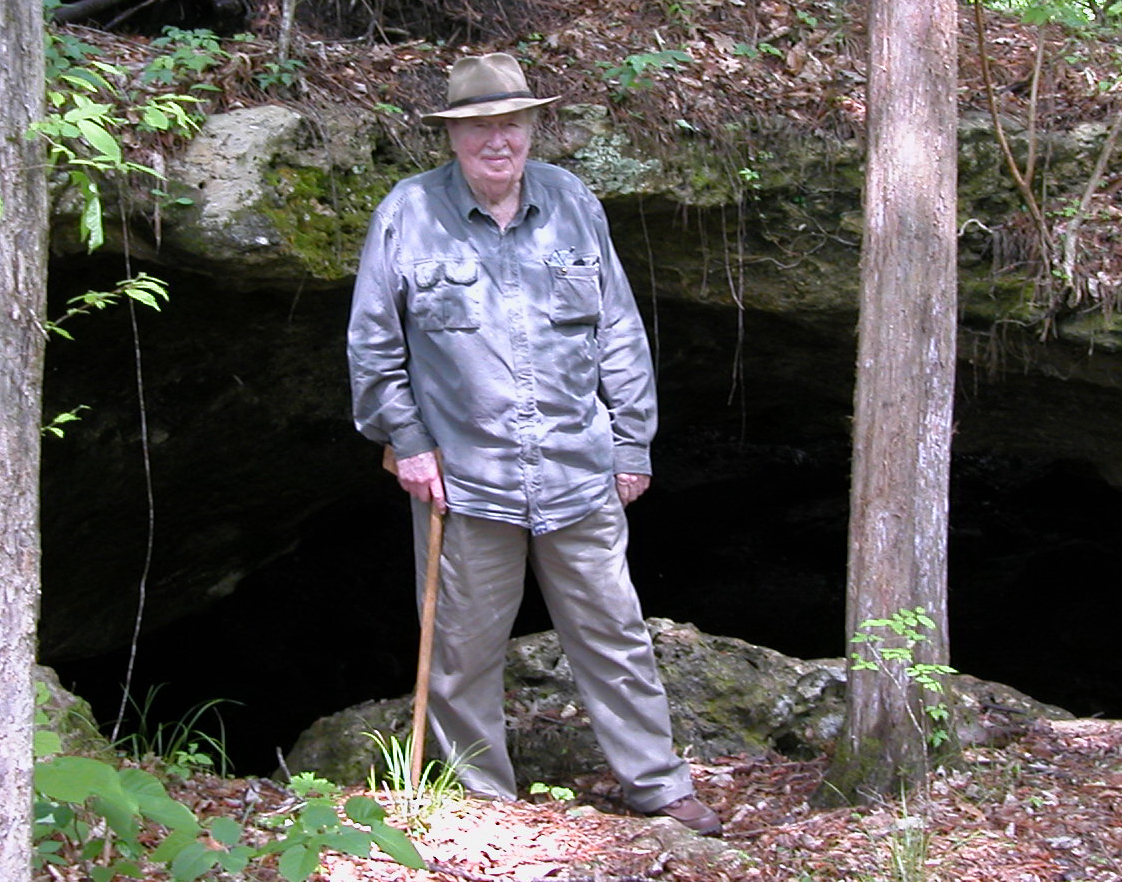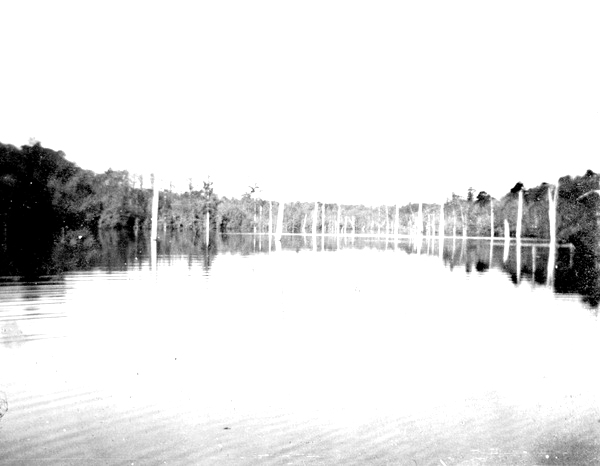|
Regional History History of Timbering County Histories Oral Histories Calhoun County Gulf County Jackson County Larry Ford Richard Hinson Laurence Pender Sarah Speights Wakulla County |
Voices from Jackson County:
Richard Hinson
Richard Hinson was born in Marianna, Florida, August 14, 1926, into an old Jackson County family. His father, one of thirteen horse and mule traders in Jackson County at the time, had moved to Marianna in 1921 from around Campbellton and Graceville, where the Hinsons had lived for four generations. Except for brief periods away at school and as a Navy SEAL in the Pacific during World War II, Mr. Hinson has lived all his life in Marianna. He and his wife Ann raised a family of four boys there. Mrs. Hinson recalls swimming at Blue Springs with her boys. When she was pregnant, they would push the raft over so she could sit on it. One night she dreamt the baby she was carrying was a turtle.
 Richard Hinson at the entrance to Alamo Cave, April 2005 |
Mr. Hinson established and ran a successful insurance agency in Marianna for many years. In 2000, he deeded 200 acres of land, including about 1.5 miles along the Chipola River to the state. The state has leased the land to the city for a park, which will eventually be linked through paddling and hiking trails to Florida Caverns State Park. A fascinating natural feature on this land is Alamo Cave, a large open cave used by Native Americans for thousands of years.
 A portion of the Chipola River that runs along the land deeded to the state by Richard Hinson |
Listen to Richard Hinson's description of the Alamo Cave: Real Network | Windows Media Player
Click here to read the text of the audio about the Alamo Cave.
 Merritts Mill Pond, 1920s. Note the clarity of the water. Credit: Florida Photographic Collection |
A lifelong nature enthusiast, Dick Hinson describes himself as a combination of Tom Sawyer and Huckleberry Finn. "I loved the outdoors all my life, especially swimming," he recounted November 21, 2004. During his childhood, there were no swimming pools in the county so people swam in ponds or springs and of course the Chipola River. As a youth, Dick would swim 3 miles from Blue Springs through the length of Merritts Mill Pond. Swimming the length of the mill pond was a rite of passage to manhood for Jackson County youth. He recalls that the water in the mill pond was so clear that you could see through the depth of 10-12 feet all the way to the bottom. "You could see all the snails that the shellcrackers fed on. It was just a beautiful site. You could drop anchor and skin-dive anywhere you wanted to."
Listen to Richard Hinson's description of Merritts Mill Pond using: Real Network | Windows Media Player
Click here to read the text of the audio about Merritts Mill Pond.
The Chipola River was a crucial source of food especially during the Depression, which hit Jackson County hard in 1935. "That river has fed a lot of families." The river was full of "brim and shellcrackers and warmouth and bass, which we called trout back in those days, and channel catfish and other types of catfish, but, of course, the channel cats were the best."
Listen to Richard Hinson's description of fishing and the Chipola River: Real Network | Windows Media Player
Click here to read the text of the audio about fishing and the Chipola River.
 Flooded houses on a tributary of the Chipola River, 1916. Credit: Florida Photographic Collection |
Mr. Hinson recalled when the Chipola would overflow its banks several times a year, flooding residential areas close to the river.
Listen to Richard Hinson's description of flooding along the Chipola River: Real Network | Windows Media Player
Click here to read the text of the audio flooding along the Chipola River.
In 1986, Richard Hinson and Sonny Anderson paddled the length of the Chipola River in a 15-foot wooden canoe. They put in at Marshall Creek, negotiated Big Look and Tremble falls, and traveled through Dead Lakes to the Apalachicola River.
Today, Richard Hinson and his wife Ann live in a house adjacent to the land they deed to the state. Built of longleaf pine shipped from Apalachicola, the house was moved from downtown Marianna in the 1970s.
profile by Elizabeth D. Purdum
Note: The content of the website has not been updated since 2005. The site remains online for it's value as legacy content and is unlikely to be updated.